Pittville’s Outdoor Swimming Baths
Introduction
Mention swimming pools in Cheltenham today, and most people will think either of Sandford Lido, or the indoor pools in Tommy Taylor’s Lane. It’s perhaps surprising to learn that the first swimming facilities in the town were established almost two centuries ago. A small-scale ‘swimming and bathing place’ was set up on a ½-acre site adjacent to the Exmouth Arms on the Bath Road in about 1820, but a few years later, a rather more elaborate enterprise had opened up on the north side of town, on the edge of Pittville.
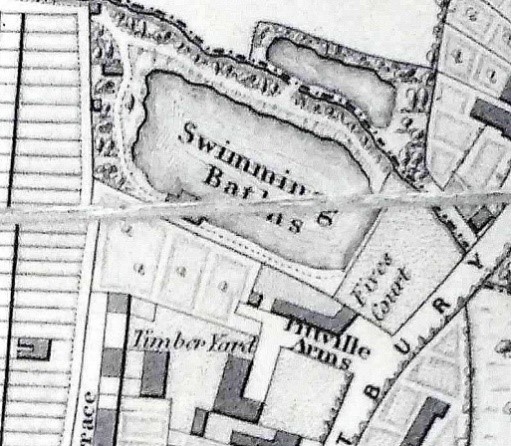 The best introduction comes via Merrett’s 1834 map. Just off the Prestbury Road, before it crosses Wyman’s Brook (so, about 50 yards north of today’s BP service station) we can see marked an extensive feature named as Swimming Baths, and an adjacent public house, the Pittville Arms, with a fives court attached. Around the swimming baths are trees or bushes, and assorted structures. A wall separates the baths from the fives court, and it appears that entry is gained from the rear of the pub. On the north side of the brook is a smaller area with its own water feature, seemingly accessed via a gap in the hedge and (presumably) a little bridge.
The best introduction comes via Merrett’s 1834 map. Just off the Prestbury Road, before it crosses Wyman’s Brook (so, about 50 yards north of today’s BP service station) we can see marked an extensive feature named as Swimming Baths, and an adjacent public house, the Pittville Arms, with a fives court attached. Around the swimming baths are trees or bushes, and assorted structures. A wall separates the baths from the fives court, and it appears that entry is gained from the rear of the pub. On the north side of the brook is a smaller area with its own water feature, seemingly accessed via a gap in the hedge and (presumably) a little bridge.
Research in local newspapers reveals that the baths, which probably operated only in the summer season, had come into being five years before Merrett’s map. An announcement in the Cheltenham Chronicle of 4 June 1829 runs thus:
PITTVILLE SWIMMING BATH
Situate on the PRESTBURY ROAD, (about five minutes’ walk from the High Street.)JOHN GOODCHILD begs respectfully to inform his friends and the public, that he has just opened the above BATHS; and that he has engaged an experienced Swimmer to instruct those Gentlemen who may wish to learn that useful art. This Bath is well adapted for Children, as it is paved and roped round in regular and graduated depths.
Goodchild was actually the lessee of the grounds. The baths formed part of a 5¼-acre plot owned by Henry Haines, a successful builder who had properties in Winchcombe Street and elsewhere on the north side of town. His name features in the building history of several Pittville houses.

Pittville Baths on the 1883 Ordnance Survey 25” map; the pond is still visible,
though reduced in size, on 1920s OS mapping.
The following week, the Chronicle commented enthusiastically, implying that this was indeed the first proper swimming bath in town: ‘The number of subscribers to these Baths since the commencement of the season affords an ample proof of the necessity that existed for such an establishment in Cheltenham; and we have much pleasure in stating that every arrangement for the accommodation of the public is now complete, two boats having recently been launched on the piece of water for the use of those who wish to indulge in the exercise of rowing.’ (It was of course not until Pittville Park had been created, in the 1890s, that rowing on the Pittville lakes was introduced.)
Goodchild seems not to have prospered, for in the Chronicle of 9 July 1829, a Mr Archer is to the fore, and we have the first press mention of the pub, here called the Pittville Inn:
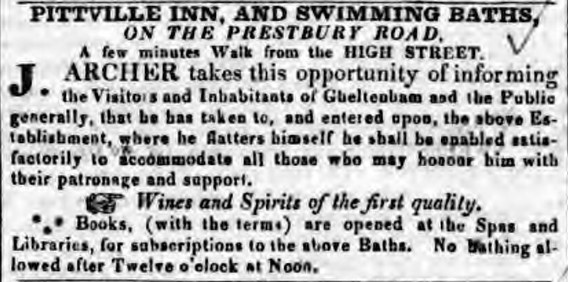
Archer’s advertisement shows certain developments: apart from the addition of a place of refreshment, which would have been the first on the route in from Prestbury, we see the morning-only rule. As the swimming was restricted to men, was this to make it easier to accommodate a mixed clientele from lunchtime onwards?
Archer was still the lessee in 1830, but did not himself advertise again. Nothing substantial is heard of the Pittville Inn or the baths until this new announcement in the Cheltenham Chronicle of 26 May 1831:
PITTVILLE SWIMMING BATHS, PRESTBURY ROAD
MESSRS. HAINES and MAGGS beg to announce to the Public, that their BATHING ESTABLISHMENT, which has undergone most extensive alterations and improvements, will now be found the most complete in the kingdom. The Baths and extensive Pleasure Gardens will be ready for the reception of the Public FRIDAY Evening, the 27th of May inst. when a Band of Music will be in attendance.
*** Several Pleasure Boats are kept on the Water.
As an established builder, Henry Haines would certainly have had the skills and resources to make whatever improvements the baths needed, but this announcement almost certainly refers to his son Thomas Haines, who at about this time entered into partnership with Thomas Maggs – the latter apparently looking for a new venture, after breaking away in January 1830 from his previous partnership in the Maggs family firm of drapers in the High Street.
The following week, the paper gave a rather fuller picture of the whole establishment, and suggests that among the changes were an increase in the size of the pool, and the introduction of tea gardens:
PITTVILLE
Subscription Swimming Bath,
And Tea Gardens,
PITTVILLE HOTEL, on the PRESTBURY ROAD. The Inhabitants of Cheltenham and its Vicinity are respectfully informed, that Messrs. HAINES and MAGGS have TAKEN to the above BATH and GARDENS, which having recently undergone great improvements and embellishments, ARE NOW OPEN, and will be conducted on such plans as they trust will meet the support of their Friends and the Public. The Swimming Bath is very spacious, covering the space of Two Acres,1 with a perpetual Current from the most delightful Hill Springs which pass on to the Lake at Pittville, so that if required the depth of the water may be rose or sunk in a very short period.2 The portion of the Bath adapted for Juvenile Bathers, is roped round, and the bottom paved to the extent of one thousand feet, which graduates in depth from 2½ feet to 5 feet.
☞ Subscription Books, with the Terms, are open at the Libraries and Pump Rooms.***Hours of Bathing from five o’clock until ten in the morning. Pleasure Boats after the hours of Bathing.
The fact that subscriptions could be taken out at the Pump Rooms may indicate that Pitt, or at least the Pittville Pump Room lessee on his behalf, was happy to have Haines and Maggs as neighbours.
As the summer progressed, and with the town crowded with racegoers, the attractions expanded to include musical concerts, firework displays, and a military band.
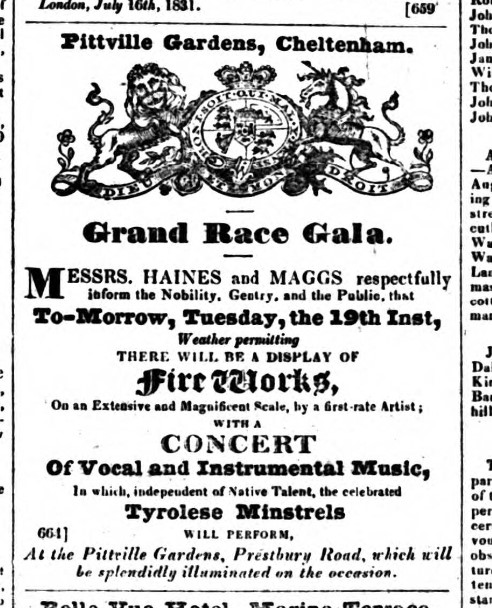
Cheltenham Journal and Gloucestershire Fashionable Weekly Gazette
18 July 1831
1831 may have been the high point of the baths’ popularity, for the following years show further changes of tenant, and little sign of additional seasonal attractions, until 1838, when, well past the end of the summer season, Cheltenham was promised a visit from the ‘Yankee Leaper’. The so-called ‘Leaper’ was a showman called Sam Scott, a native of Philadelphia and a former sailor who had made his name and his living by leaping (or diving) from great heights such as ships’ masts and cliffs. He had arrived in the British Isles in late 1837, and executed his feats around the country. After ‘extraordinary performances’ in Bristol, in early October he dived 60ft from the top-mast of a barque into the canal at Gloucester docks. Reporting this, the Chronicle of Thursday 4 October promised that ‘this afternoon’ he would jump from a scaffold 100 feet high into the pond at the Pittville Hotel.
Performances such as Scott’s were generally subject to a sufficient crowd having gathered, and it seems numerous Cheltonians were willing to put money in the hat when it was passed round: a week later, the Chronicle recorded that he had been ‘exhibiting his prowess for some days past at the Pittville Hotel’.
In 1839, all we hear of the Pittville Hotel is that a Chartist meeting was held in its gardens on the evening of 17 July, when a Mr Henry Vincent delivered a ‘moral discourse’ on the present state of Chartism. A large crowd of both sexes attended.
After this point, there is no evidence that the hotel, gardens or swimming bath were functioning. The final press reference to the hotel is in the Cheltenham Examiner of 11 March 1840, reporting that three lads had been charged with cutting and damaging the lead on the roof of a summer-house belonging to the Pittville Hotel – a sign perhaps that the establishment was in decline. Although probably aimed at different types of patron, it is likely that the hotel and baths had for several years been unable to compete with the flourishing entertainments programme at the Pump Room and elsewhere in the Pittville grounds. By 1838, there would also have been competition from the new Fox and Hounds public house, only a few yards up the road on the Prestbury side of Wyman’s Brook.
Later references to a Pittville Hotel, in the 1850s, are to a separate establishment in Winchcombe Street.
Tailpiece
At some point in the 1840s Henry Haines moved to the Pittville Hotel and baths site, the former hotel then becoming his residence, when it was renamed Southam Villa. He died there in January 1850, aged 65, after a long illness, leaving to his son Thomas ‘all that … house known as Southam Villa, with timber yard, stables, coach house and stable yard adjoining’. Thomas Haines, who had already taken over the family building business, and recorded in the 1851 census as the employer of 200 men, was himself to die suddenly only months later, in November 1851, of a stroke or seizure.
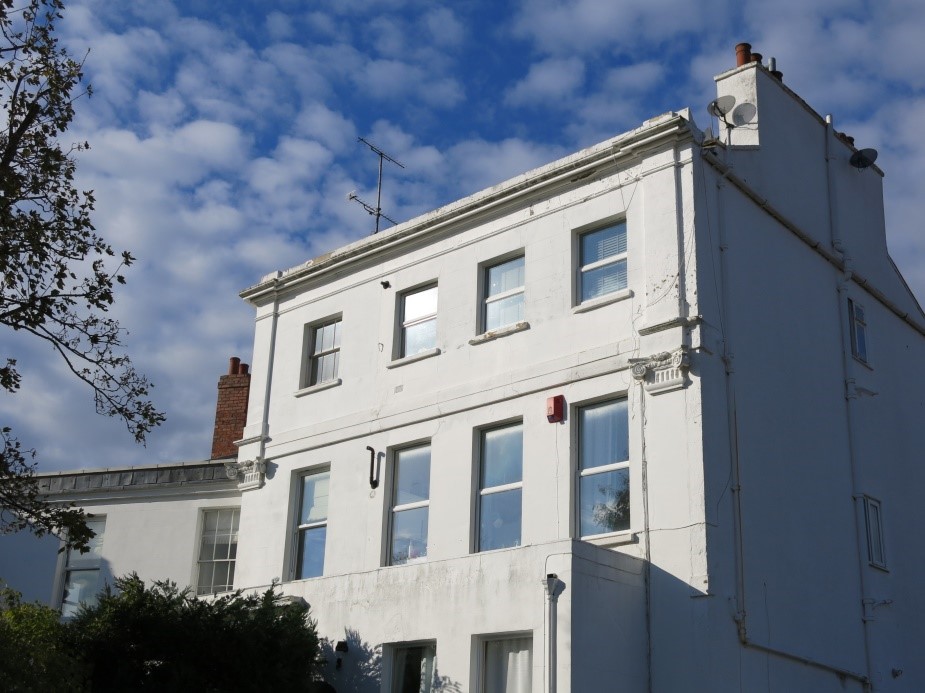
98 Prestbury Rd today
Of the swimming bath, which on an 1853 deed is marked simply as ‘fish pond’, and on the 1855-7 Old Town Survey even more laconically as ‘pond’, no trace remains. The area is now concreted over, the storage yard of a construction firm.
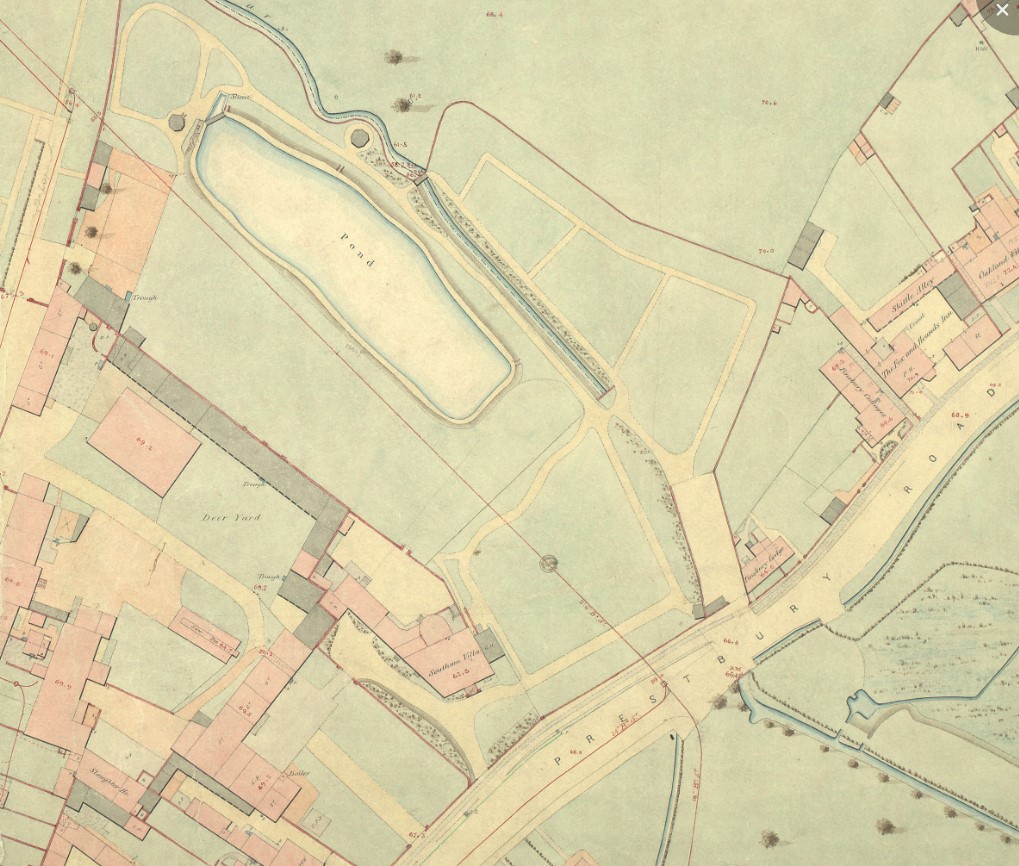
1855-7 Cheltenham Old Town Survey
James Hodsdon

though reduced in size, on 1920s OS mapping.

Subscription Swimming Bath,
And Tea Gardens,
PITTVILLE HOTEL, on the PRESTBURY ROAD.

18 July 1831

